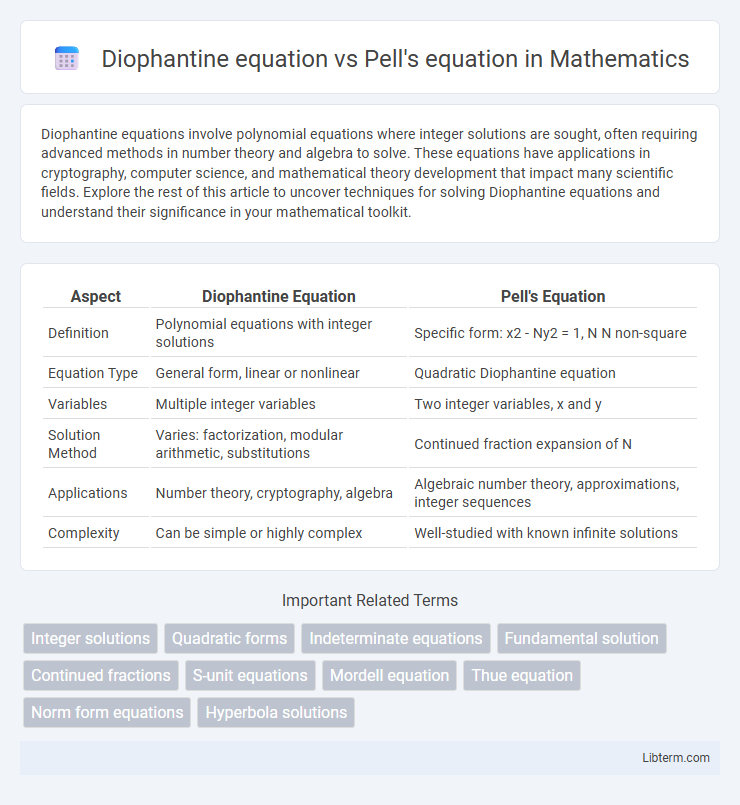Diophantine equations involve polynomial equations where integer solutions are sought, often requiring advanced methods in number theory and algebra to solve. These equations have applications in cryptography, computer science, and mathematical theory development that impact many scientific fields. Explore the rest of this article to uncover techniques for solving Diophantine equations and understand their significance in your mathematical toolkit.
Table of Comparison
| Aspect | Diophantine Equation | Pell's Equation |
|---|---|---|
| Definition | Polynomial equations with integer solutions | Specific form: x2 - Ny2 = 1, N N non-square |
| Equation Type | General form, linear or nonlinear | Quadratic Diophantine equation |
| Variables | Multiple integer variables | Two integer variables, x and y |
| Solution Method | Varies: factorization, modular arithmetic, substitutions | Continued fraction expansion of N |
| Applications | Number theory, cryptography, algebra | Algebraic number theory, approximations, integer sequences |
| Complexity | Can be simple or highly complex | Well-studied with known infinite solutions |
Introduction to Diophantine Equations
Diophantine equations are polynomial equations where integer solutions are sought, named after the ancient mathematician Diophantus. These equations vary widely, including linear and nonlinear forms, and often require specialized techniques for finding integer solutions. Pell's equation, a specific type of Diophantine equation expressed as x2 - Dy2 = 1, illustrates the complexity and significance of such problems in number theory.
Understanding Pell's Equation
Pell's equation, a specific type of Diophantine equation, takes the form x2 - Dy2 = 1, where D is a non-square positive integer. This equation is notable for its infinite integer solutions (x, y), which are found using fundamental solutions and continued fractions related to D. Understanding Pell's equation involves mastering methods to generate all solutions from the minimal one, making it a key topic in number theory and algebraic number fields.
Historical Background and Significance
Diophantine equations, originating from the ancient Greek mathematician Diophantus, are polynomial equations with integer solutions that have fascinated mathematicians for centuries. Pell's equation, a specific form of Diophantine equation expressed as x2 - Ny2 = 1, gained prominence through work by mathematicians like Fermat and Euler during the 17th and 18th centuries. Both types of equations hold significant historical importance, influencing number theory and algebraic developments while providing foundational challenges in finding integer solutions.
General Form of Diophantine Equations
Diophantine equations are polynomial equations typically expressed in the form \( a_1x_1 + a_2x_2 + \dots + a_nx_n = b \), where \(a_i\), \(b\), and solutions \(x_i\) are integers, emphasizing finding integer or rational solutions. Pell's equation, a specific type of Diophantine equation, takes the form \( x^2 - Dy^2 = 1 \) with \(D\) as a non-square integer, highlighting its unique quadratic structure and infinite integer solutions. The general form of Diophantine equations encompasses linear and nonlinear cases, requiring methods like modular arithmetic, the Euclidean algorithm, or advanced number theory for solving.
Unique Properties of Pell’s Equation
Pell's equation, a specific form of Diophantine equation expressed as x2 - Dy2 = 1 for a non-square positive integer D, is distinguished by its infinite set of integer solutions generated from its fundamental solution. Unlike general Diophantine equations, Pell's equation involves quadratic forms and exhibits a recursive structure that forms units in the ring of integers of quadratic fields. This unique link to continued fractions and algebraic number theory enables precise determination of solutions and intricate patterns absent in other Diophantine equations.
Methods of Solving Diophantine Equations
Methods of solving Diophantine equations often involve integer solutions to polynomial equations, encompassing techniques such as modular arithmetic, the Euclidean algorithm, and bounding arguments. Pell's equation, a specific type of Diophantine equation of the form x2 - Dy2 = 1, is typically solved using continued fractions to find the fundamental solution, which generates infinitely many solutions. Advanced methods also include descent techniques and algebraic number theory approaches to handle more complex Diophantine problems.
Pell’s Equation: Special Solutions and Techniques
Pell's equation, defined as x2 - Dy2 = 1 where D is a non-square positive integer, exhibits special solutions derived from the continued fraction expansion of D. Fundamental solutions can generate infinitely many other solutions through recursive techniques involving the equation's norm properties in quadratic fields. Techniques like Chakravala method and algebraic number theory provide efficient algorithms to find minimal solutions, emphasizing Pell's equation as a pivotal case in the study of Diophantine equations.
Key Differences Between Diophantine and Pell’s Equations
Diophantine equations encompass a broad class of polynomial equations with integer solutions, whereas Pell's equation is a specific type of Diophantine equation of the form x2 - Dy2 = 1, where D is a non-square positive integer. The key difference lies in Pell's equation's unique structure that allows the use of continued fractions to find solutions, contrasting with the general Diophantine approach, which may require various methods depending on equation complexity. Pell's equation specifically addresses integer solutions in the context of quadratic forms, while Diophantine equations cover a wider range including linear, nonlinear, and higher degree polynomial equations.
Applications in Modern Mathematics
Diophantine equations and Pell's equations play crucial roles in modern mathematics by addressing integer solutions to polynomial equations and quadratic forms, respectively. Diophantine equations find applications in cryptography, coding theory, and algorithmic number theory due to their complexity and solution constraints. Pell's equations specifically are instrumental in studying algebraic number theory, continued fractions, and solving problems related to quadratic fields and integer approximations.
Conclusion and Future Perspectives
Diophantine equations encompass a broad class of polynomial equations with integer solutions, whereas Pell's equation is a specific type characterized by the form x2 - Dy2 = 1, where D is a non-square integer. Advances in algorithmic number theory have improved computational methods for solving Pell's equation, highlighting its significance in cryptography and algebraic number theory. Future research is expected to deepen the understanding of solution structures and extend applications to modern fields such as quantum computing and integer optimization.
Diophantine equation Infographic

 libterm.com
libterm.com